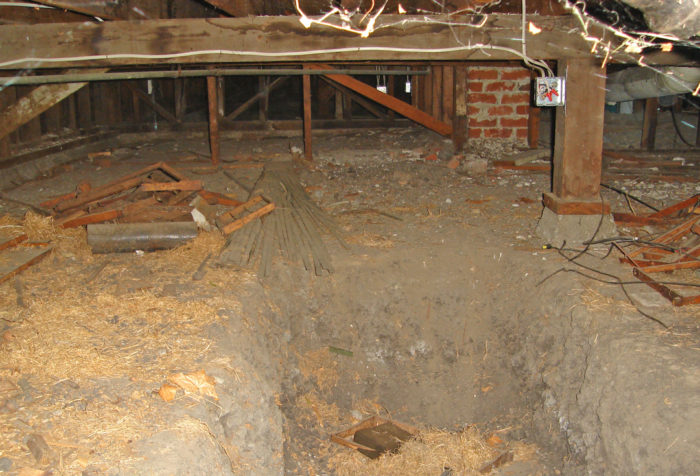Crawl spaces are common in many residential and commercial buildings, providing access to utilities, ventilation, and insulation. While some crawl spaces are excavated to create additional headroom and access space, others remain unexcavated, retaining their original condition. In this comprehensive guide, we’ll explore unexcavated crawl spaces in detail, including their definition, characteristics, advantages, considerations, and best practices for maintenance.
Definition and Characteristics:

An unexcavated crawl space is a crawl space that has not been dug out or modified from its original condition. Unexcavated crawl spaces typically have limited clearance height and may contain soil, rocks, or other debris. They are commonly found in older homes or buildings where excavation was not performed during construction. Unexcavated crawl spaces vary in size and shape depending on the layout and design of the building. They are typically accessed through small openings or access doors located on the exterior or interior of the structure. Unexcavated crawl spaces may have dirt floors, concrete slabs, or gravel surfaces, depending on the construction methods.
Advantages of Unexcavated Crawl Spaces:
Despite their limited clearance height and access space, unexcavated crawl spaces offer several advantages:
Cost Savings:
Unexcavated crawl spaces typically require less labour and materials than excavated ones, resulting in cost savings for builders and homeowners. The lower upfront costs make unexcavated crawl spaces a more budget-friendly option for new construction or renovations.
Minimal Site Disturbance:
Since unexcavated crawl spaces do not require digging or excavation, they involve minimal site disturbance. This can be advantageous for properties with limited space, challenging terrain, or environmental sensitivities where excavation may not be feasible or desirable.
Natural Insulation:
The soil beneath unexcavated crawl spaces can provide natural insulation, helping to regulate temperatures and reduce energy consumption. While additional insulation may still be needed, the soil can act as a thermal barrier, especially in regions with moderate climates.
Considerations for Unexcavated Crawl Spaces:
While unexcavated crawl spaces offer advantages, they also present some considerations and challenges:
Limited Headroom:
One of the primary drawbacks of unexcavated crawl spaces is the limited clearance height and access space. Crawling or crouching may be required to navigate the space, which can be uncomfortable and impractical for performing maintenance and repairs.
Moisture and Ventilation Issues:
Unexcavated crawl spaces may be more prone to moisture buildup, poor ventilation, and humidity than excavated crawl spaces. Unexcavated crawl spaces can become breeding grounds for mould, mildew, and pests without proper ventilation and moisture control measures.
Insulation Challenges:
Insulating unexcavated crawl spaces can be more challenging than excavated ones due to limited access and clearance height. Specialised insulation techniques, such as spray foam insulation or rigid foam board insulation, may be required to insulate unexcavated crawl spaces effectively.
Pest Infestation:
Unexcavated crawl spaces may be more susceptible to pest infestation, including rodents, insects, and other unwanted critters. Cracks, gaps, and openings in the foundation or walls can provide entry points for pests, leading to potential damage and health hazards.
Best Practices for Maintenance:
Despite the challenges of unexcavated crawl spaces, proper maintenance and management can help mitigate potential issues and ensure a safe and healthy environment. Here are some best practices for maintaining unexcavated crawl spaces:
Regular Inspection:
Inspect the crawl space for signs of moisture, mould, pests, and structural damage. Look for damp or musty odours, water stains, wood rot, and pest droppings, and address any issues promptly.
Moisture Control:
Implement moisture control measures to prevent excess humidity and moisture buildup in the crawl space. Install vapour barriers, dehumidifiers, and sump pumps to keep the space dry and well-ventilated.
Ventilation:
Ensure adequate ventilation in the crawl space to promote air circulation and prevent stagnant air. Install vents, fans, or vents to allow fresh air to enter and moisture-laden air to escape, reducing the risk of mould growth and moisture-related issues.
Insulation:
Properly insulate the crawl space to improve energy efficiency and temperature regulation. Use insulation materials resistant to moisture and pests, and seal any gaps or openings to prevent air leakage and heat loss.
Pest Control:
Implement pest control measures to prevent infestations and protect the crawl space from damage. Seal entry points, remove food sources, and consider using baits, traps, or professional pest control services to deter pests and rodents.




